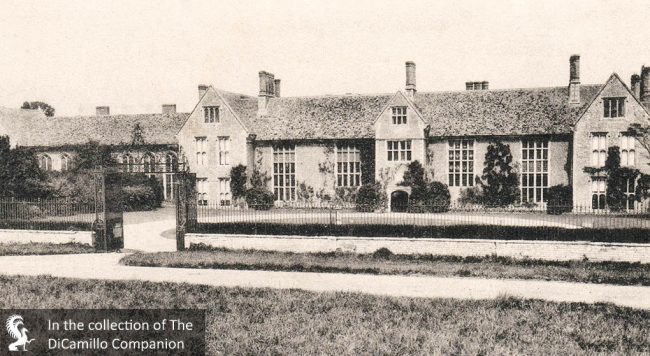
The house from a 1903 postcard
Earlier Houses: There was an earlier Medieval manor house on, or near, the site of the current house.
Built / Designed For: Darrell family
House & Family History: In 1589 Sir John Popham, Elizabeth I’s infamous lord chief justice, acquired Littlecote, the only major brick mansion in Wiltshire, as a bribe from the Darrell family, who built the house. This transaction took place because Sir John, who was sitting as a trial judge, remained silent during the trial of “Wild” William Darrell for infanticide. Darrell was clearly an ugly human being. He was accused of a series of crimes, including incest, but is particularly remembered for the 1577 accusation that he threw a newly born illegitimate infant into the fire at Littlecote (it’s very likely that Darrell was the father of the child, whose mother was a serving woman in his household). Littlecote passed out of the Popham family in 1929, when the estate was purchased Sir Ernest Salter Wills; it remained with the Wills family until 1985, when Sir David Wills sold Littlecote to entrepreneur Peter De Savary. In 1996 Warner Leisure Hotels acquired the estate and converted the house into a hotel. Littlecote was visited by Charles II and William of Orange and is rumored to have been a location where Henry VIII wooed Jane Seymour. In May of 2021 M.A. Katritzky, research fellow at The Open University, published important research that makes a strong case that Littlecote’s famous Dutch Parlour was painted by English artists in the 1720s, not Dutch captives in the 1660s, as had widely been believed for centuries. The ceiling and wood paneled walls of the room are covered in paintings that were always believed to be the work of Dutch sailors who were captured during the Second Anglo-Dutch War (1665-67) and held as prisoners at Littlecote. Katritzky’s research suggests that, not only is the work by English artists, but that William Hogarth (1697-1764) may have been involved in the wall paintings. Before he became famous as a satirical painter and printmaker, Hogarth was an important wall painter; it was previously believed that none of his early wall paintings survived. Katritzky’s research revealed that the Dutch Parlour shows images from 17th century literary bestsellers on its walls: The west wall has scenes from Cervantes’s “The Ingenious Gentleman Don Quixote of La Mancha,” aka “Don Quixote,” while the east wall features scenes from Samuel Butler’s narrative poem “Hudibras,” which was influenced by “Don Quixote.” Though “Hudibras" was first published in the 1660s, the illustrated edition didn’t come out until 1710; it is images from this edition that are painted on the walls of Littlecote, proving that the artwork was created 50 years after the Second Anglo-Dutch War ended.
Garden & Outbuildings: In 1730 an ancient Roman mosaic pavement with a central design of Apollo playing a harp surrounded by mounted female figures was discovered in the park. When Warner Holidays purchased the house in 1996 they also acquired 84 acres of Grade II-listed historic parkland and gardens, which included a 17th-18th century walled garden.
Chapel & Church: Littlecote has an unusual Cromwellian chapel.
John Bernard (J.B.) Burke, published under the title of A Visitation of the Seats and Arms of the Noblemen and Gentlemen of Great Britain and Ireland, among other titles: Vol. I, p. 5, 1852.
John Preston (J.P.) Neale, published under the title of Views of the Seats of Noblemen and Gentlemen in England, Wales, Scotland, and Ireland, among other titles: Vol. V, 1822.
Country Life: XII, 400, 1902. CXXXVIII, 1406 plan, 1466, 1620, 1678, 1965.
Title: Buildings of England: Wiltshire, The
Author: Pevsner, Nikolaus; Cherry, Bridget
Year Published: 1999
Reference: pgs. 297-299
Publisher: London: Penguin Books
ISBN: 0140710264
Book Type: Hardback
House Listed: Grade I
Park Listed: Grade II
Past Seat / Home of: SEATED AT EARLIER HOUSE: Durnford family, 12th century. de Calstone family, 13th century. SEATED AT CURRENT HOUSE: William Darrell, until 1589. Sir John Popham, 1589-1607; Sir Francis Popham, until 1779; Leyborne-Popham family here from 1589 until 1929. Sir Ernest Salter Wills, 20th century; Wills family here from 1929 until 1985.
Current Ownership Type: Corporation
Primary Current Ownership Use: Hotel
Ownership Details: Today Littlecote House Hotel
House Open to Public: By Appointment
Phone: 01488-682-509
Fax: 01488-682-341
Website: https://www.warnerleisurehotels.co.uk
Historic Houses Member: No